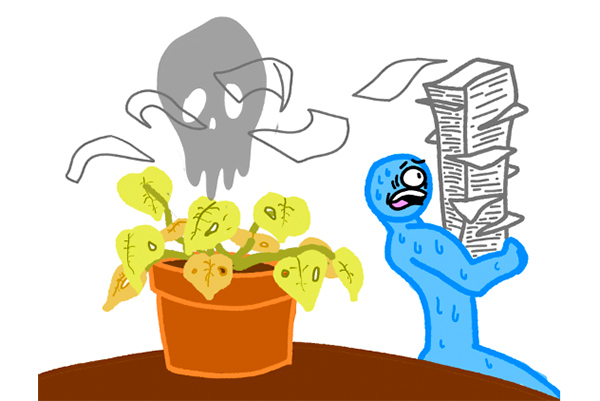College dorms can be dark, desolate and musty rooms that reek of ramen and despair, but they don’t have to be.
In addition to being an aesthetically pleasing addition to any room’s decor, some houseplants are scientifically proven to detoxify the air, boost productivity and reduce stress.
Although adorning every corner of an apartment with lush, green plants seems impossible with a busy schedule and limited college budget, it is possible to be a successful parent of multiple, thriving potted plants. Here are The Daily Texan’s tips on starting a collection:
Stick to these plants
Ace Osbourne, who works at the garden center in Home Depot, recommends any variety of succulents, dracaena, peace lily, philodendron, pothos or snake plants as beginner plants.
For students living in less-than-ideal housing, dracaena is known for purifying chemical compounds from the air — particularly xylene, which is emitted from household objects such as floor coverings, copy machines and paint.
Mathematics sophomore Emma McKelvain said she recommends varieties of herbs or ivy vines. Fragrant herbs, such as rosemary and basil, can be both aesthetically-pleasing and useful for cooking.
Shop smart
“I go to places like IKEA, Wheatsville Co-op and local plant nurseries,” Alexandra Waldinger, a marketing senior, said. “IKEA also has a nice variety of pots and other planting materials, so you can get it all in one stop.”
For students who don’t have disposable income to spend on houseplants, only one plant is needed to begin a collection. Propagating plants, or growing new plants from the trimmings and seeds of existing plants, is a slow but thrifty method that can save money and resources.
“Propagating depends on the plant and the season, but for pothos it works year-round,” Osbourne said. “Simply break off a root stub, stick it in water and let it sit until the roots are grown — then gently transfer them to soil before it gets acclimated to life in water.”
The Daily Texan does not endorse students taking trimmings from indoor plants in public UT buildings.
Watch the water
“Overwatering is what I see kill most plants,” Osbourne said. “Underwatering is rarely an issue because the plant will obviously start to appear wilted and shriveled.”
Although it may seem plausible to water houseplants everyday, Osbourne said doing so can oversaturate the soil.
“I combat overwatering succulents by placing several ice cubes in the pot and letting it melt, watering the plant throughout the day,” Laura Pike, a communication and leadership freshman said.
Beware of the Texas heat
Although a plant’s needs seem simple enough, many forget the Texas sun is extremely harsh for houseplants, Osbourne said.
“Putting your houseplants by a westward-facing window and exposing them to afternoon sun is a surefire way to kill (them),” Osbourne said. “If you can, find a window facing east. The sun coming from that direction won’t fry them.”
Being cautious of plants that are potted in heat-conductible containers is also important, Osbourne said.
“Plants wouldn’t have a problem if they were sitting in the ground,” Osbourne said. “But if they’re in a pot directly in sunlight the entire soil can heat up and fry the plant.”




















